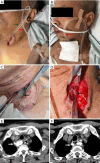A novel stepwise and continuous high-volume irrigation drainage technique for managing cervical anastomotic leaks post-esophagectomy
- PMID: 40809257
- PMCID: PMC12340320
- DOI: 10.21037/jtd-2024-2158
A novel stepwise and continuous high-volume irrigation drainage technique for managing cervical anastomotic leaks post-esophagectomy
Abstract
Background: Recently, minimally invasive surgical modalities have become the mainstream approach for the treatment of esophageal cancer, but the incidence rate of anastomotic leak (AL) has not significantly decreased. Compared to intrathoracic anastomoses, cervical anastomotic leaks (CALs) occur at a higher rate. However, there is still a lack of consensus regarding the local management for CALs. In recent years, we have innovated an irrigation and drainage technique for patients with CALs. The aim of this article is to investigate the therapeutic effect of this novel technique.
Methods: The current study was designed as a retrospective study. Patients with CALs in Shanghai Changzheng Hospital were included consecutively. Data regarding healing time (HT), frequency of dressing changes (DC), post-operative hospital stay, mortality, morbidity, as well as laboratory indicators, such as white blood cell count (WBC), C-reactive protein (CRP), procalcitonin (PCT), and interleukin-6 (IL-6) were recorded.
Results: The current study included a total of 53 patients with CALs. Among them, 26 patients received conventional DC treatment (DC group), while 27 patients were treated with irrigation and drainage treatment (IDT) group. IDT significantly expedited the HT of CALs (45 vs. 22 days, P<0.01), reduced the frequency of DC (2.6 vs. 1.5 times/day, P<0.01), shortened the length of post-operative hospital stay (76.5 vs. 43 days, P<0.01), and decreased the mortality rate of patients (15.4% vs. 0%, P<0.05). Additionally, the incidence of sepsis (23.1% vs. 3.7%, P<0.05) and pneumonia (30.8% vs. 7.4%, P<0.05) significantly decreased in the IDT group. Laboratory tests indicated that IDT significantly reduced the CRP and IL-6 levels on the 3rd and 7th days of treatment.
Conclusions: The irrigation and drainage technique is an effective treatment for CALs and merits broad implementation within clinical practice.
Keywords: Esophageal cancer; anastomotic leak (AL); irrigation and drainage treatment (IDT).
Copyright © 2025 AME Publishing Company. All rights reserved.
Conflict of interest statement
Conflicts of Interest: All authors have completed the ICMJE uniform disclosure form (available at https://jtd.amegroups.com/article/view/10.21037/jtd-2024-2158/coif). The authors have no conflicts of interest to declare.
Figures



Similar articles
-
Prescription of Controlled Substances: Benefits and Risks.2025 Jul 6. In: StatPearls [Internet]. Treasure Island (FL): StatPearls Publishing; 2025 Jan–. 2025 Jul 6. In: StatPearls [Internet]. Treasure Island (FL): StatPearls Publishing; 2025 Jan–. PMID: 30726003 Free Books & Documents.
-
The measurement and monitoring of surgical adverse events.Health Technol Assess. 2001;5(22):1-194. doi: 10.3310/hta5220. Health Technol Assess. 2001. PMID: 11532239
-
Home treatment for mental health problems: a systematic review.Health Technol Assess. 2001;5(15):1-139. doi: 10.3310/hta5150. Health Technol Assess. 2001. PMID: 11532236
-
The Black Book of Psychotropic Dosing and Monitoring.Psychopharmacol Bull. 2024 Jul 8;54(3):8-59. Psychopharmacol Bull. 2024. PMID: 38993656 Free PMC article. Review.
-
The impact of postoperative atrial fibrillation on complications and mortality following Ivor Lewis esophagectomy for esophageal cancer.Sci Rep. 2025 Jul 1;15(1):22305. doi: 10.1038/s41598-025-06239-8. Sci Rep. 2025. PMID: 40596337 Free PMC article.
References
-
- Morgan E, Soerjomataram I, Rumgay H, et al. The Global Landscape of Esophageal Squamous Cell Carcinoma and Esophageal Adenocarcinoma Incidence and Mortality in 2020 and Projections to 2040: New Estimates From GLOBOCAN 2020. Gastroenterology 2022;163:649-658.e2. 10.1053/j.gastro.2022.05.054 - DOI - PubMed
LinkOut - more resources
Full Text Sources
Research Materials
Miscellaneous
